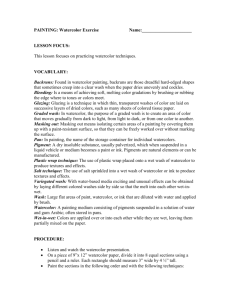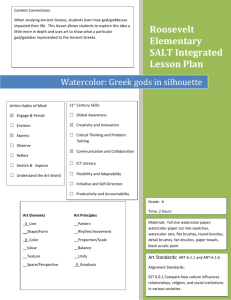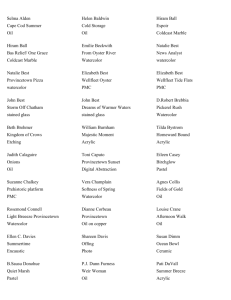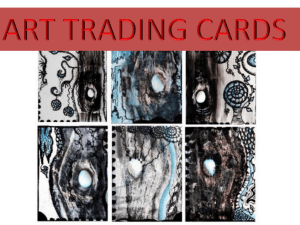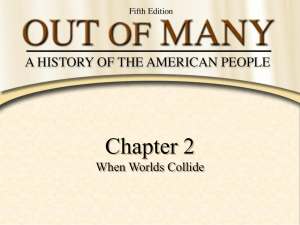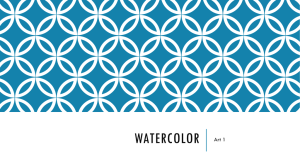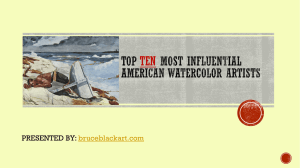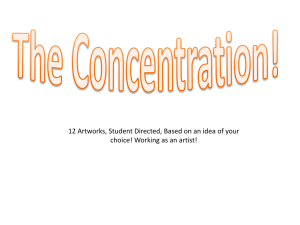History of Watercolor
advertisement
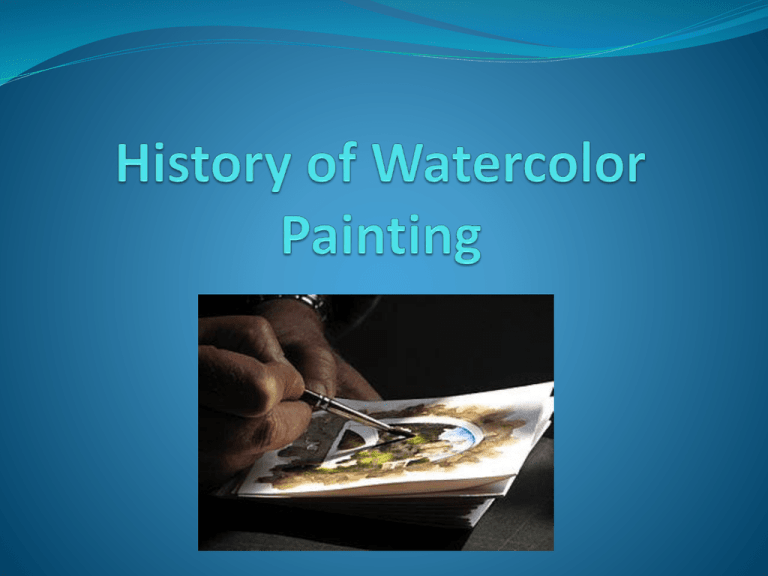
Objectives Understand that Albrecht Durer is the western artist who began a major change in watercolor painting Learn the importance of various artists’ contribution to watercolor painting Recognize the characteristics of watercolor painting Understand the impact the invention of paper had on watercolor painting Recognize the change of watercolor painting from a craft to a fine art On a timeline, place watercolor painting as it began to evolve into a fine art after the Renaissance In the beginning… The use of watercolors dates back to prehistoric times with cavemen painting on cave walls Some illuminated manuscripts were made with watercolor paint It was not until about A.D. 500 that watercolor painting came to be considered a fine art, when Chinese poet-painters helped it evolve from being primarily a decorative craft in the East. Chinese and Japanese masters painted on silk as well as exquisite handmade paper. Their art was filled with calligraphy, but the main image was usually a landscape. This characteristic became a central theme of Western watercolor traditions in later centuries. Invention of Paper Paper has also played an important role in the development of watercolor. China has been manufacturing paper since ancient times. The Arabs learned their secrets during the eighth century. Paper was imported to Europe until the first papermaking mills were finally established in Italy in 1276. A few other mills developed later in other parts of Europe, while England developed its first mills by 1495. However, high-quality paper was not produced in Britain until much later during the eighteenth century. Watercolor as a sketch… Since paper was considered a luxury item in these early ages, traditional Western watercolor painting was slow in evolving. The increased availability of paper by the fourteenth century finally allowed for the possibility of drawing as an artistic activity. So artists like Leonardo da Vinci and Michelangelo began to develop drawings as a tool for practice and for recording information. Albrecht Dürer In the West, Albrecht Dürer (1471-1528) has been credited with upgrading the level of watercolors and began using them for more than sketching and planning. Primarily a printmaker, he was looking for a way to color areas of his prints and ended up using a combination of transparent and opaque watercolors to produce colored drawings. The Wire-Drawing Mill. 1489. Watercolour and gouache on paper Albrecht Dürer (German) A Young Hare 1502, watercolor and gouache on paper, 25 x 23 cm Albrecht Dürer The Large Piece of Turf, 1503 watercolor and gouache on yellowed paper 41 x 32 cm Paper in England after 1768 In 1770, England began producing paper made especially for watercolor paint. With the production of higher quality papers ,first national school of watercolorists emerged in Britain. This watercolor tradition began with landscape drawings from the late seventeenth and early eighteenth centuries as Britain began to grow as a world power. These map-like paintings were of ports of sea, as well as the surrounding landscape. The most talented watercolorist from this period was Joseph M.W. Turner (English, 1775-1851) who went on to become one of the greatest painters of the nineteenth century. His landscapes influenced dozens of artists during later decades. Joseph Mallard William Turner J. M. W. Turner (1775-1851) (English) applied new transparent and opaque watercolors with sponges, rags, and knives, as well as with brushes. He is considered part of the original English (transparent) watercolor school. For many years, English watercolor painters were more skilled than any other artists in the world Warkworth Castle, Northumberland Thunder Storm Approaching at Sun-Set. 1799. Watercolour on paper Joseph Mallard William Turner View of Saint-Germain-ea-Laye and Its Chateau. Watercolour on paper Early watercolorists ground their own pigments, but by the late eighteenth century the Englishman, William Reeves, was selling them in portable cakes. In 1846, Winsor & Newton introduced colors packaged in metal tubes. This growing technology encouraged many European artists to experiment with watercolors until eventually the tradition spread to America. Capturing the NEW WORLD on paper The earliest watercolor drawings produced in America were created for factual documentation of the "new world." As early as the 1560's, European explorers carried this visual information back to the "old world". America Gradually Excels European watercolorists were still superior to Americans. Gradually, skilled and talented artists from America began to develop artworks which challenged European artists. American artists saw watercolor as a primary medium equal to oil painting. This was not common in nineteenth century Europe except in England. By 1866, the interest in the medium was strong and for the first time watercolors were shown in galleries among oil paintings. American Artists Take the Lead America's contribution to the international watercolor tradition is second to none. Although the British dominated that tradition in the past, American artists have produced a important and varied body of work in watercolor that is unmatched elsewhere in the world since the late eighteenth century. Artists such as Winslow Homer, John Singer Sargent, John James Audubon are famous for their major works in watercolor paints. Winslow Homer (American) 1836-1910 Boys and Kitten, 1873 Winslow Homer The Blue Boat 1892 Water color JOHN SINGER SARGENT (American) 1856-1925 Muddy Alligators, 1917 John Singer Sargent Gondoliers’ Siesta 1904 John James Audubon The paintings of American wildlife by John James Audubon (American, 17851851) became famous. Audubon did his first study in 1805. He eventually devoted himself to painting the animals and plants of North America with such skill that no other artist has equaled in any other medium. Virginian Partridge, 1829 John James Audubon Trumpeter Swan Golden Eagle Watercolor Paintings Today

